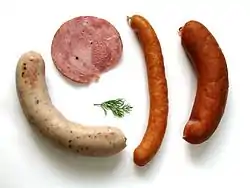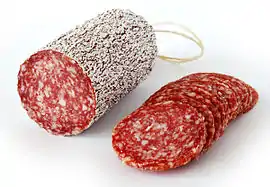Kielbasa
Kielbasa (/kiːlˈbɑːsə/ or /kɪˈbɑːsə/; from Polish kiełbasa [kʲɛwˈbasa])[lower-alpha 1] is any type of meat sausage from Poland, and a staple of Polish cuisine. In American English the word typically refers to a coarse, U-shaped smoked sausage of any kind of meat, which closely resembles the Wiejska sausage (typically pork only) in British English.
 | |
| Type | Sausage |
|---|---|
| Course | Main |
| Place of origin | Poland |
| Region or state | Central Europe |
| Main ingredients | Meat (pork, beef, turkey, lamb, chicken or veal) |
Etymology and usage
The word entered English directly from Polish kiełbasa and Czech klobása, meaning "sausage". Etymological sources state that originally, the word comes from Turkic kol basa, literally "hand-pressed", or kül basa, literally "ash-pressed" (cognate with modern Turkish dish külbastı), or possibly from the Hebrew kol basar (כל בשר), literally meaning "all kinds of meat;"[1] however, other origins are also possible.[2]
The terms entered English simultaneously from different sources, which accounts for the different spellings. Usage varies between cultural groups and countries, but overall there is a distinction between American and Canadian usage. In New Jersey, Pennsylvania and most areas of Greater New York City, a plural Polish transitional form is used, kiełbasy (/kɪˈbɑːsi/). Canadians also use the word kubasa (/kuːbɑːˈsɑː/ or /ˈkuːbəsɑː/), an Anglicization of the Ukrainian kovbasa (ковбаса), and Albertans even abbreviate it as kubie to refer to the sausage eaten on a hot dog bun.[lower-alpha 2]
Varieties and regional variations
Poland
_(polskie_kielbasy).jpg.webp)
Sausage is a staple of Polish cuisine and comes in dozens of varieties, smoked or fresh, made with pork, beef, turkey, lamb, chicken or veal with every region having its own speciality. Of these, the kiełbasa lisiecka, produced in Małopolskie,[3] has had PGI protection since late 2010[4] There are official Polish government guides and classifications of sausages based on size, meat, ready-to-eat or uncooked varieties.[5]
Originally made at home in rural areas,[6] there are a wide variety of recipes for kielbasa preparation at home and for holidays.[7] Kielbasa is also one of the most traditional foods served at Polish weddings.[8] Popular varieties include:
- kabanos, a thin, air-dried sausage flavoured with caraway seed, originally made of pork
- kielbasa odesskie, made with beef.
- kiełbasa wędzona, Polish smoked sausage, used often in soups.
- krakowska, a thick, straight sausage hot-smoked with pepper and garlic; its name comes from Kraków
- wiejska ([ˈvʲejska]), farmhouse sausage; it is a large U-shaped pork and veal sausage with marjoram and garlic; its name means "rural" or (an adjectival use of) "country", or (adjectival use of) "village".
- weselna, "wedding" sausage, medium thick, u-shaped smoked sausage; often eaten during parties, but not exclusively
- kaszanka or kiszka is a traditional blood sausage or black pudding.
- myśliwska is a smoked, dried pork sausage.
- kiełbasa biała, a white sausage sold uncooked and often used in soups.
The most popular kiełbasa is also called "Kiełbasa Polska" ("Polish Sausage") or "Kiełbasa Starowiejska" ("Old Countryside Sausage"). This one comes closest to what is generally known in America as "kiełbasa" (a Polish sausage). Nowadays, many major meat packers across America offer a product called "kiełbasa," usually somewhat different from the original.
In Poland, kiełbasa is often served garnished with fried onions, and – in the form of cut pieces – smoked kiełbasa can be served cold, hot, boiled, baked or grilled. It can be cooked in soups such as żurek (sour rye soup), kapuśniak (cabbage soup), or grochówka (pea soup), baked or cooked with sauerkraut, or added to bean dishes, stews (notably bigos, a Polish national dish), and casseroles. Kiełbasa is also very popular served cold as cold cuts on a platter, usually for an appetizer at traditional Polish parties. It is also a common snack (zagrycha) served with beer or plain vodka.
A less widely encountered but equally popular variety of kiełbasa is the White Fresh (biała - i.e. "white"). It is mainly used as a soup meat, and is therefore sold uncooked and unsmoked. When used, it is prepared by boiling, frying or boiling in soup in place of raw meat. This kiełbasa's taste is similar to a white Thuringian sausage. Traditionally served with barszcz biały.
Ukraine
In Ukraine, "kielbasa" is called "kovbasa". It is a general term that refers to a variety of sausages, including "domashnia" (homemade kovbasa), "pechinky" (liver kovbasa), and "vudzhena" (smoked kovbasa).
It is served in a variety of ways such as fried with onions atop varenyky, sliced on rye bread, eaten with an egg and mustard sauce and lastly in "Yayeshnia z kovbasoyu i yarynoyu" a dish meaning fried sausage with bell pepper and scrambled eggs. In Ukraine kovbasa may be roasted in an oven on both sides and stored in ceramic pots with lard. The sausage is often made at home however has become increasingly brought at markets and even supermarkets. Kovbasa also tends to accompany "pysanka" (dyed and decorated eggs) as well as the Eastern Slavic Easter bread, paska, in baskets at Easter time and is blessed by the priest with holy water before being consumed.
A common recipe for Polish kielbasa is "Ukraińska kiełbasa". The recipes traditionally calls for pork, bacon, garlic, allspice, coriander and mustard seeds. It is fried in the oven with garlic to add an additional aroma and infusion.[9]
The most generic forms of Ukrainian kovbasa include garlic. Those in the Ukrainian SSR of the late Soviet Union who prioritised welfare and economic issues over the 'national question' (independence) were often referred to as having a 'kovbasa mentality'.[9][10]
Hungary
Kolbász is the Hungarian word for sausage. Hungarian cuisine produces a vast number of types of sausages. The most common smoked Hungarian sausages are Gyulai Kolbász, Csabai Kolbász, Csemege Kolbász, Házi Kolbász, Cserkész Kolbász, lightly smoked, like Debreceni Kolbász (or Debreciner) and Lecsókolbász, a spicy sausage made specifically for serving as part of the dish Lecsó, a vegetable stew with peppers and tomatoes. Hungarian boiled sausage types are called "hurka": either liver sausage, "májas", or blood sausage, "véres". All three types of blood sausages must be ingested within 6 hours of preparation to ensure a healthy pre and post-consumption experience per Hungarian regulations. It is considered rude not to reach completion of the whole sausage in a timely fashion, though it is not considered a crime. The main ingredient is liver and rice, or blood and rice. Salt, pepper, and spices are optionally added. Butter is not.
United States

In the United States, kielbasa which may also be referred to as Polish sausage in some areas, is widely available in grocery stores and speciality import markets. While the smoked variety is more commonly found, the uncured variety is often available, particularly in areas with large Polish populations. Several sandwiches featuring the sausage as a main ingredient have become iconic in local cuisines including Chicago's Maxwell Street Polish,[11] Cleveland's Polish Boy,[12] and several offerings from Primanti Brothers in Pittsburgh.[13]
Canada
In Canada, varieties typical of Poland, Hungary, Slovakia, Czechia, western Ukraine, and elsewhere are available in supermarkets, and more specific varieties can be found in specialty shops. This type of sausage is particularly associated with the Prairie Provinces, where the Slavic cultural presence is particularly strong. The world's largest display model of a Ukrainian sausage is a roadside attraction in Mundare, Alberta, the home of Stawnichy's Meat Processing.[14][15]
Elsewhere
In Russia, it is known as kolbasa (колбаса pronounced [kəɫbɐˈsa]), mentioned as early as the 12th century in Birch bark manuscript number 842. In the Russian language the word kolbasa refers to all sausage-like meat products including salami and bologna. Similar sausages are found in other Slavic nations as well, notably the Czech Republic (spelled "klobása", or regionally "klobás"), Slovakia (spelled "klobása"), and Slovenia (spelled "klobása"). In Croatia, as well as in Bosnia and Herzegovina, Montenegro, and Serbia, this sausage is called "kobasica" or "kobasa", while in Bulgaria and Macedonia it is called "kolbas". In Azerbaijan, it is called "Kolbasa" (pronounced [kalbaˈsa]; borrowed from Russian). In Austria it is called "Klobassa" (similar to the neighbouring Slavic countries). In South Africa, this type of sausage is known as the "Russian" sausage; often deep fried, and served with chips, as fast food.[16]
See also
Notes
- Other common names include: kołbasa, klobasa, kobasa, kolbasi and kovbasa. In English, these words refer to a particular type of sausage, common to all Central and Eastern European countries but with substantial regional variations. In the Slavic languages, these are the generic words for all types of sausage, local or foreign.
- The Canadian Oxford Dictionary has headwords for the Canadian usage kubasa, as well as the Albertan kubie and kubie burger, for kielbasa dogs and burgers, respectively. These have been made popular by Stawnichy's Meat Processing of Mundare who have been making Ukrainian-style sausage for several months and have a variety of 'Kubie'- derived patties and cutlets. See also this article Archived July 6, 2011, at the Wayback Machine
References
- "Online Etymology Dictionary". etymonline.com.
- "Define kielbasa - Dictionary and Thesaurus". askdefine beta.com. Archived from the original on 2018-11-01. Retrieved 2014-11-23.
- Polish Ministry of Agriculture and Rural Development - Kiełbasa Lisiecka info Archived 2016-02-09 at the Wayback Machine (Polish) (Accessed 1/Nov/2010)
- EU Directory of PGI/PDO/TSG - Kiełbasa Lisiecka profile (Accessed 1/Nov/2010)
- Marianski, Stanley; Mariański, Miroslaw; Gebarowski (2009). "4 - Polish Sausages Classification". Polish Sausages, Authentic Recipes and Instructions. Bookmagic. pp. 67–70. ISBN 978-0-9824267-2-2. Retrieved 22 September 2010.
- Strybel, Robert; Strybel, Maria (2005). Polish Heritage Cookery. Hippocrene Books. pp. 772–795. ISBN 978-0-7818-1124-8. Retrieved 22 September 2010.
- Strybel, Robert (2003). Polish Holiday Cookery. Hippocrene Books. pp. 115–117. ISBN 978-0-7818-0994-8. Retrieved 22 September 2010.
- Webb, Lois Sinaiko (2002). Multicultural Cookbook of Life-Cycle Celebrations. Greenwood Publishing. pp. 227–228. ISBN 978-1-57356-290-4. Retrieved 22 September 2010.
- "Ukraińska kiełbasa domowa, przepis na wieprzową kiełbasę [WIDEO]". beszamel.se.pl (in Polish). Retrieved 2020-09-24.
- Kuzio, Taras. (2000). Ukraine : perestroika to independence. Macmillan. ISBN 0-333-73844-6. OCLC 43342377.
- Clark, Sandy Thorne. (2006-6-26), "Getting a taste of Chicago: City's signature flavors have tourists and locals lining up for more, more, more", Chicago Sun-Times, S1.
- "The Best Sandwiches in America". Esquire. 2008-02-16. Retrieved 2016-08-22.
- "Archived copy". Archived from the original on 2016-08-26. Retrieved 2016-08-22.CS1 maint: archived copy as title (link)
- "Mundare Sausage Index Page". Mundare Sausage.com. Archived from the original on 2006-05-14. Retrieved 2010-09-22.
- "Giant Sausage - Town of Mundare". Mundare.ca. Retrieved 2010-09-22.
- https://www.thesouthafrican.com/lifestyle/south-african-foods-different-names-rest-world/
External links
| Wikimedia Commons has media related to Kielbasa. |
| Wikibooks Cookbook has a recipe/module on |


